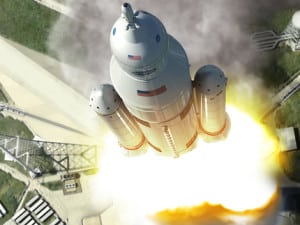13 CubeSats Make the Grade for NASA SLS Mission
[Via Satellite 02-03-2016] NASA has selected 13 CubeSats to test new technology on the first flight of the agency’s upcoming rocket, the Space Launch System (SLS), set to pave the way for deep space exploration. Launching in 2018, the new rocket aims to first propel an unmanned Orion spacecraft beyond the moon and into deep space, with NASA’s sights set on a journey to Mars. The small satellite secondary payloads will fly on SLS’ Exploration Mission-1 (EM-1) to carry out science and technology investigations in deep space and, hopefully, set the course for future human exploration into deep space.
“Exploration Mission-1 will be a proving ground mission, whose goal is to demonstrate the integrated performance of SLS and Orion before we put crews on it for the first crewed flight. Because of the robust capability of the Space Launch System, we have a unique opportunity to transport small spacecraft and technology experiments onboard the very same mission,” said Todd May, Marshall Space Flight Center director, during a press event held at the center in Huntsville, Ala., to announce the small satellite fleet selection on Feb. 3.
According to NASA’s website, the CubeSats will be deployed following the Orion capsule’s separation from the upper stage. Once Orion is a safe distance away, a spring mechanism will eject each payload from dispensers on the Orion stage adapter. Following deployment, the transmitters on the CubeSats will turn on, and ground stations will listen for their beacons to determine the functionality of these small satellites.
Bill Hill, deputy associate administrator of Exploration Systems Development at NASA Headquarters, noted that the organization began looking at 11 payloads before deciding that there were sufficient resources to launch 13 CubeSats. Of the 13, NASA announced seven of the missions.
NASA’s Science Mission Directorate selected and spoke to the first two publically announced missions, including, CuSP, a mission described by Michael Seablom, chief technologist for NASA’s Science Mission Directorate at NASA Headquarters, as a “space weather station” that aims to measure particles and magnetic fields in space, and further understand the particles’ roles in geothermal storms. It also looks to test practicality for a network of stations to monitor space weather. The solar activity that causes space weather can impact both space exploration missions and satellites for telecommunications and remote sensing.
Seablom also spoke to the LunaH-Map mission, which will map hydrogen that exists within craters, on the plains and in other permanently shadowed regions at the Moon’s south pole.
“Because of the investments we’ve made in technology, this mission, which will carry a neutron spectrometer, and also an imager, will give us unprecedented horizontal resolution of the distribution of hydrogen. Roughly seven-and-a-half kilometers per pixel is what we’re expecting,” said Seablom. The CubeSat will also feature an advanced propulsion system with about 12 miniature thrusters to provide attitude control and enable the CubeSat to make more than 140 orbits over its planned 60-day lifecycle.
NASA also selected two payloads through the Next Space Technologies for Exploration Partnerships (NextSTEP). These two missions include Skyfire, a Lockheed Martin Space Systems-designed CubeSat, to perform a flyby of the Moon and collect infrared sensor data to enhance knowledge of the lunar surface, and the Lunar IceCube mission from Morehead State University, which will search for water ice and other resources at a low orbit of only 62 miles above the surface of the Moon.
NASA’s Human Exploration and Operations Mission Directorate selected three payloads for the Orion mission: the Near Earth Asteroid (NEA) Scout mission, built by NASA’s Jet Propulsion Laboratory (JPL), which will perform reconnaissance of an asteroid, take pictures and observe its position in space; the BioSentinel mission, which plans to use yeast to detect, measure and compare the impact of deep-space radiation on living organisms over long durations in deep space; and Lunar Flashlight, a mission that plans to look for ice deposits and identify locations where resources may be extracted from the lunar surface.
Further CubeSats have yet to be chosen, but NASA will determine three additional payloads through the organization’s Cube Quest Challenge, a contest designed to “foster innovations in small spacecraft propulsion and communications techniques,” NASA Deputy Administrator Dava Newman explained. As part of the challenge currently taking place, CubeSat builders will compete for a chance to launch their spacecraft on the SLS mission. NASA’s Space Technology Mission Directorate will select and announce the winning payloads in 2017.
Furthermore, NASA has reserved room for three payloads from international partners. According to Hill, NASA is in advanced discussions surrounding which international missions will be selected to fly onboard the SLS, and the organization will announce the payloads at a later date.
“All the data from these missions and these experiments will be used to help us on our journey to Mars,” said May.
NASA is designing SLS EM-1 to have a minimum lift of 77 tons, powered by twin boosters and four RS-25 engines, which are currently undergoing testing. In 2015 the agency saw the completion of multiple engine tests preparing the SLS for launch, including a major rocket booster test for which the agency is preparing for a follow up in May, according to Hill.
“The space launch system, Orion and the ground systems that support both pre-launch and recovery are making great progress,” he said.
